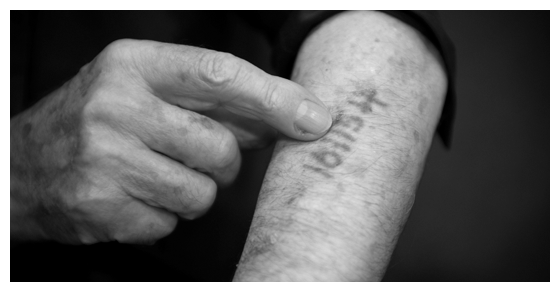
Wearing Their Grandparents’ Tattoos: A New Generation Remembers the Holocaust
A number tattoo on the left forearm is a familiar symbol of the Nazi Holocaust. On the body of a Jewish Holocaust survivor, the tattoo communicates the fact that the wearer survived the brutality and lived to tell the story. What meanings are communicated about the Holocaust, however, when younger generations of Jewish people tattoo their ancestors’ Auschwitz numbers on their own bodies?
This practice has gained visibility and generated controversy in recent years—Jewish offspring of Holocaust survivors (some children, but mostly grandchildren) choosing to tattoo their own bodies with the Auschwitz numbers that were forcibly tattooed on their ancestors. When we first encountered a newspaper story about this practice, we were struck by how controversial and disturbing it seemed. We were familiar with uses of tattoos that were explicitly political (e.g., people with HIV or AIDS acquiring a tattoo that announces their diagnosis), and we were familiar with uses of tattoos to express and manage experiences of trauma (e.g., people tattooing mastectomy scars). Nevertheless, these progenic tattoos seemed to generate unique controversy on several levels: within Judaism, some argue that the Torah clearly and explicitly prohibits tattooing, and some misperceive that a person with tattoos cannot be buried in a Jewish cemetery. Additionally, because the Auschwitz tattoo is such a symbol of brutality and calculated dehumanization, it seems unimaginable that anyone would choose to repeat it on their body.
We were particularly interested in how progeny of Jewish Holocaust survivors justified their controversial choices within the context of Jewish traditions and family relations. What reasons did they give for acquiring this tattoo, and what sorts of effects did the new wearers imagine their tattoo would have? We looked for all of the instances of this practice we could find in various media, including newspaper accounts, website discussions, and the documentary video Numbered. Across these texts, we witnessed several forms of justification: the trauma of the Holocaust is carried across generations and is part of the new wearer’s cultural, religious, and familial heritage; the blood link to the ancestor transforms the new tattoo into a memorialization of the ancestor; acquiring the tattoo participates in the broader imperative to “Never Forget” the Holocaust; and acquiring the tattoo changes the meaning of the symbol from Jewish victimhood to continued survival. Additionally, some new wearers emphasized they had sought and received permission from their ancestors.
It became clear to us this practice must also be interpreted within the context of the impending deaths of all living Holocaust survivors. Noting the challenges of offering a definitive accounting, the United States Holocaust Memorial Museum claims that more than 195,000 Holocaust survivors are alive today. Soon, however, Holocaust survivors will no longer be alive to share their testimony in person and in the flesh. This fact produces an urgency to create new ways to keep not just individual and family but also public memory of the Holocaust alive. The progenic Auschwitz tattoo represents a new, unique, and contentious form of public memory in these urgent conditions.
For many of the new wearers, their hope for the tattoo is that it will both memorialize a specific family member and inspire public memory of the Holocaust more broadly. For the new tattoo to have this effect, viewers must be willing to rethink the relationship between the Auschwitz number and the person who bears it. That is, the original Auschwitz tattoo served as direct, physical evidence that its wearer experienced the Holocaust. When a grandchild or child willingly places the tattoo on her body, she is not communicating direct experience of suffering internment of Auschwitz. Instead, she is communicating the fact that the Holocaust happened, that her ancestor directly experienced it, and that memory of the Holocaust must be kept alive. Within Jewish families, fourth and fifth and further generations of Holocaust survivors may never directly encounter their survivor-ancestor. Some new wearers of the tattoo anticipate having to teach these future generations what the symbol means at familial and historical levels.
Progenic tattoos promise to generate wider public discussion about the Holocaust and proper ways of remembering it. Imagine an encounter on the street or other public place with a person wearing a number tattoo on the left forearm. Imagine further that this person is 20-something, 30-something, or 40-something. For this tattoo to be effective in its effort to generate discussion, several dynamics are key: The viewer must have some historical sense of what this number—or what a number like this—means. If the viewer recognizes the tattoo as an Auschwitz number, then the viewer must also have some curiosity about why this number is appearing “out of place” (on the “wrong” body) and out of time. The progenic tattoo might prompt the viewer to pose questions to its wearer to get more information. These participatory and interactive dynamics invite viewers of the tattoo to collaborate, directly or indirectly, with wearers of the tattoo in producing Holocaust memory. Whether the practice of progenic tattooing dwindles or becomes increasingly common, we believe it will continue to be a topic of conversation and controversy.

